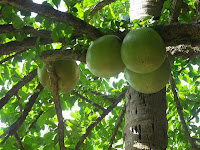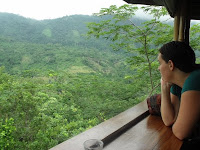Continuing my Volta Weekend, at this point I'm still in Tafi Atome
My favorite part of the Tafi Atome was walking through the village. The traditional houses in Ghana are extremely different region from region. Some are round and in a compound, some many square houses in a compound, some are only one house for all activities, while others regions have separate houses/huts for different activities.
Left: Tafi Atome had different huts for different activities. The structure to right is the kitchen and to the left is the house. It's still under construction
 One major difference in Volta was people asked to have their picture taken. In Accra, I never walk around with my camera for fear of being marked as a new visitor and then harassed. In Bolgatanga if you asked to take a picture of someone many set a price at 12 cidis ($10 US), which is their right but I prefer not to take the picture. But in Volta they want their pictures taken, even when told you cannot give them the hard copy.
One major difference in Volta was people asked to have their picture taken. In Accra, I never walk around with my camera for fear of being marked as a new visitor and then harassed. In Bolgatanga if you asked to take a picture of someone many set a price at 12 cidis ($10 US), which is their right but I prefer not to take the picture. But in Volta they want their pictures taken, even when told you cannot give them the hard copy.Right: The women in black are dressed for a funeral. The style is the traditional Ghanaian style. Funerals can go on for 3 days and can sometimes take up to a year to plan (depending on the size and general wealth of the family)
The Calabash tree is my favorite tree in Ghana. In my head, I call them watermelon trees because the fruits are so large. The shells are extremely useful and Ghanaians use them as cups, bowls, or serving dishes, depending on the size of the calabash. The trees can be most often seen on the road from Kumasi to Tamale. One of my bosses was surprised I saw one in Volta, I feel very lucky.

I visited a yam garden in Tafi Atome and found the plants very strange. The leaves grew on a very weak stem; they looked more like vines to me. The villagers attached the stems to sticks to increase the size of the yam. The yam then grows beside the plant, creating a mound. The yams can then be roasted, fried, or mashed and used to create Banku. On returning to Accra I found out Volta is famous for its delicious Banku, sadly I didn't eat any :o(
Right: Bamboo is holding up the vine. The mound on the right is the growing yam.
Left: Palm wine trader. There was a simple four-post structure with a roof made of a banana tree and palm leaves to create shade. Men were drinking here at midday. The trader is about to hand me that half calabash in his hand.
As all the Hohoe tro-tros were full, we stayed the night in Fume at Paradise Mountain Lodge. The view was enchanting. High mountains covered in forest, a scattering of wildflowers, and large termite mounds.
Right: Morning picture of the view from Mountain Paradise Lodge, the mists slowly lifting with the rising of the sun. The sign Woe Zo means welcome.
Having stayed the night in Fume, we decided to hike there instead of heading towards the famous Wli falls. Left is our map of the 2-hour hike, as the trail is confusing (many interweaving trails along the way) a guide led the way.

The highlight of the hike was this small waterfall. Growing the rocks were beautiful pink flowers ... love nature!
Ropes are attached to that tree as we had to abseil down a little cliff to get to the falls. As always I find going up a lot easier than going down.
Right: Yolanda and me at Kulugu falls.
 Parts of the forest are cleared for farming. The deforestation angered Yolanda, who is an environmental scientist but she also acknowledged the people's right to harvest cheap food. To farm or not to farm, is that the question?
Parts of the forest are cleared for farming. The deforestation angered Yolanda, who is an environmental scientist but she also acknowledged the people's right to harvest cheap food. To farm or not to farm, is that the question?Right: Yolanda and William, our guide, in a field of local maize. In Bolga they have millies, here they have maize
Below: Left is a picture of cocoa yam, and right are cassava plants. Both are like the yam plants above, the tuber grows in a mound near the plants' stem.
Left: View from Mountain Paradise Lodge's Bar, the last drink of fresh pineapple juice sweetened the view before we headed back to Accra.
Sunday was the reverse of Saturday, empty tros to Hohoe, full tros heading back to Accra. After waiting 30 minutes at Fume Junction and seeing 10 full tros pass us we ended up taking the 30 minutes tro north to Hohoe to grab a tro going straight south to Accra. Somehow we made it back home in 3.5 hours (expected it to be Col6), perhaps we were flying!
Volta may have been my last travel trip in Ghana. Before I leave I'll try to show you some of Accra. Somehow I've managed to spend all this time in the city but have no photos!






































